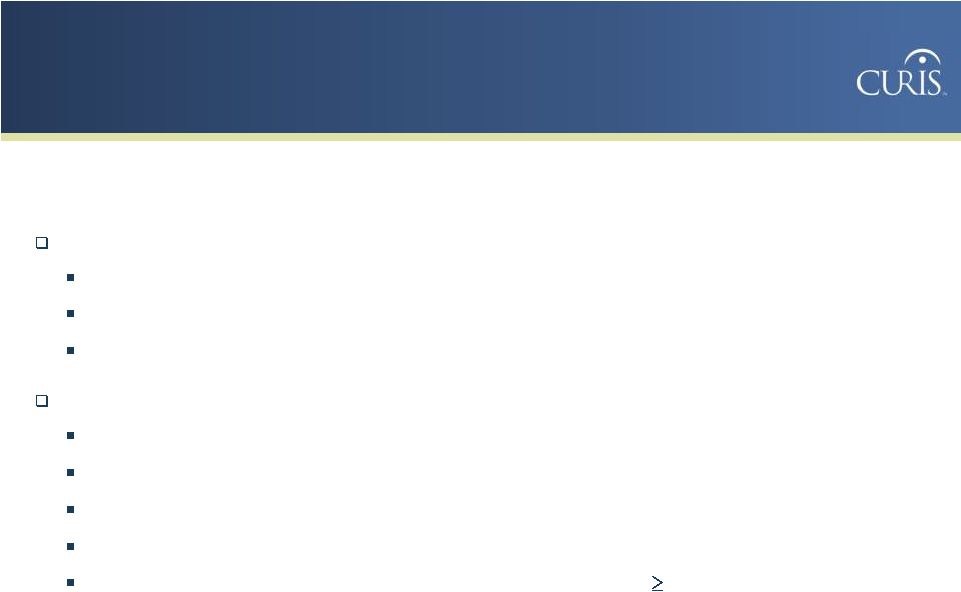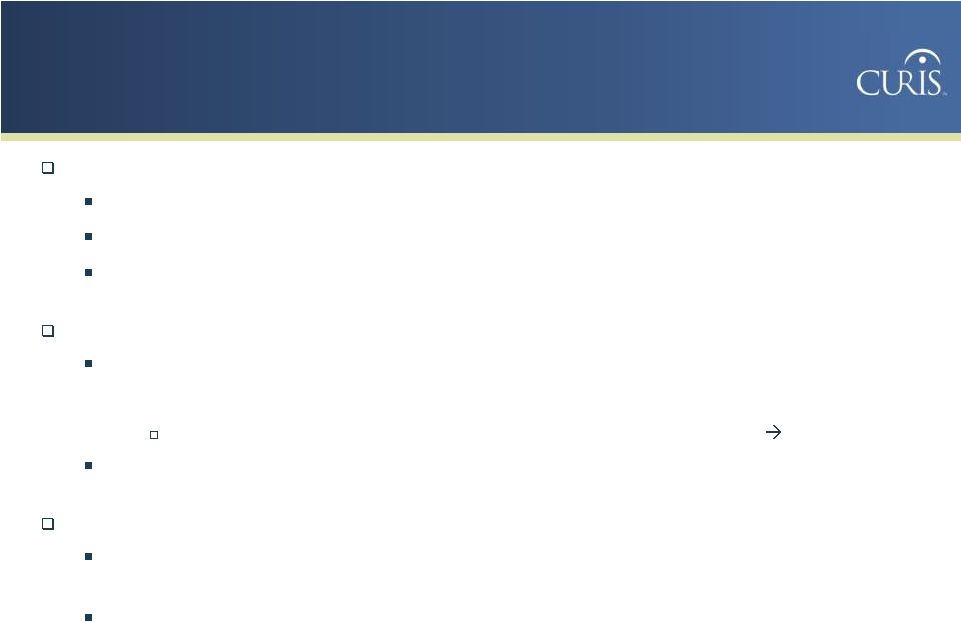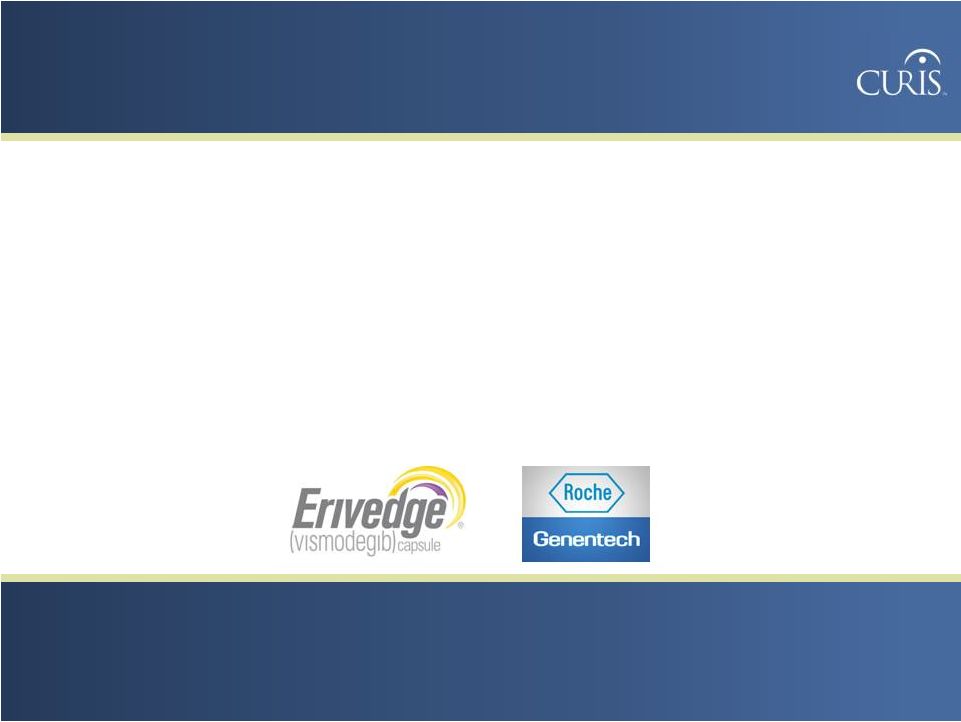Attached files
| file | filename |
|---|---|
| 8-K - FORM 8-K - CURIS INC | d655173d8k.htm |
 0
NASDAQ: CRIS
Corporate Overview
January 13, 2014
Exhibit 99.1 |
 1
Forward Looking Statements
This
presentation
contains
statements
about
Curis’
future
expectations,
plans
and
prospects
that
constitute
forward-looking
statements
for
purposes
of
the
safe
harbor
provisions
of
the
Private
Securities
Litigation Reform Act of 1995. Actual results or events could differ materially
from the expectations, plans and prospects disclosed in the
forward-looking statements that the Company makes due to a number of
important factors, including risks related to: the Company’s ability to
satisfactorily respond to the FDA’s request for additional data and
analysis regarding CUDC-427 with respect to the partial clinical hold and its
ability to conduct future preclinical or clinical studies involving CUDC-427 if
the FDA or other regulatory agencies
continue
to
express
safety
concerns
even
if
the
hold
is
lifted;
Genentech
and
Roche’s
ability
to
successfully
develop
and
commercialize
Erivedge;
the
Company’s
and
its
collaborators’
ability
to
successfully research, obtain regulatory approvals for, develop and commercialize
products based upon the Company’s technologies; the Erivedge
royalty-collateralized loan transaction entered into by the Company’s
wholly-owned subsidiary, including the risk that it may not receive sufficient
levels of royalty revenue
from
sales
of
Erivedge
to
satisfy
the
debt
obligation
or
may
otherwise
lose
its
rights
to
royalties
and
royalty
related
payments
as
a
result
of
a
foreclosure
of
the
loan;
the
Company’s
ability
to
obtain
and
maintain
proprietary
protection
for
its
technologies
and
product
candidates;
competitive
pressures;
the
Company’s ability to raise additional funds to finance its operations; and
those risk factors discussed in the Company’s Quarterly Report on Form
10-Q for the quarter ended September 30, 2013, and other reports that it
files with SEC. The forward-looking statements included in this
presentation represent our views as of the date of this presentation. We
anticipate that subsequent events and developments will cause our views to change.
While we may elect to update these forward-looking statements in the future, we
specifically disclaim any obligation to do so. These forward-looking
statements should not be relied upon as representing our views
as of any date subsequent to the date of this presentation.
|
 2
HDAC/PI3K
Indications
Indications
Market
Market
NSCLC
Lymphomas and
Multiple Myeloma
Target
Target
Program
Program
Preclinical
Preclinical
Phase 1
Phase 1
Phase 2
Phase 2
Phase 3
Phase 3
CUDC-907
Debio 0932
Clinical Pipeline
Novel, Targeted Cancer Therapeutics
Renal Cancer
Advanced Basal Cell
Carcinoma
Operable Basal Cell
Carcinoma
Erivedge®
AML and MDS
Proprietary Programs
Partnered Programs
Hsp90
Hedgehog
IAP
CUDC-427
Breast, Ovarian,
Lymphomas, and
Other Cancers
Phase 1*
Phase 1
Approved in US, AUS, EU & Others
Phase 2
Phase 1b/2
Phase 1
Phase 1/2
* CUDC-427 is currently on an FDA partial clinical hold.
|
 3
CUDC-907:
Potent Inhibitor of HDAC and PI3K Enzymes |
 4
Oral, first-in-class highly potent and selective inhibitor of HDAC and PI3K
enzymes
Preclinical highlights
Hematological indications clinical highlights
Clinical testing in solid tumor indication(s) anticipated in late 2014
CUDC-907 Summary
Inhibition of PI3K, MAPK and JAK/STAT pathways in hematologic tumor models
Potential
biomarkers predicting CUDC-907 sensitivity
Phase 1 dose escalation study ongoing in lymphoma and multiple myeloma
patients Side
effect
profile
consistent
with
target
inhibition
–
thrombocytopenia,
diarrhea,
fatigue
Preliminary evidence of anti-tumor activity based on 1 PR & 7 SD out of 13
patients Dose escalation phase projected for completion in mid 2014
Dose
expansion
phase
(DLBCL
&
MM)
projected
for
initiation
in
2H
2014
Phase 2 testing in hematological indication(s) anticipated late 2014
|
 5
CUDC-907: Dual Activity against HDAC & PI3K
M2
•
~ 80% PI3K activity as
compared to parent
•
No HDAC activity
M1
•
~ 30% PI3K activity as
compared to parent
•
No HDAC activity
PI3K
IC50 (nM)
Alpha
Delta
Beta
Gamma
19
39
54
311
HDAC
IC50 (nM)
1
2
3
6
10
4, 5, 7, 8, 9
1.7
5.0
1.8
27
2.8
>200
CUDC-907
•
Full HDAC activity
•
Full PI3K activity
H
2
N
O
R
R
R
H
O
O
R
HDACi Moiety
PI3Ki Moiety |
 6
CUDC-907 & M2 Tissue Distribution in Mouse
Informs Clinical PK Model
Mouse 25 mg/kg Single Dose, PO
Differential kinetics & distribution of CUDC-907 & M2 metabolite
M1 & M2 levels higher in plasma than CUDC-907 levels
CUDC-907 is predominantly distributed to tissues
CUDC-907
M2 |
 7
CUDC-907: Phase 1 Clinical Design
Phase 1 dose-escalation monotherapy study
Relapsed/refractory lymphoma or multiple myeloma patients
MSKCC (Anas Younes, MD), SCRI (Jesus Berdeja, MD), MDACC (Yasuhiro Oki, MD)
3+3 design
1
o
Objective
Determination of MTD and recommended Phase 2 dose (RP2D)
2
o
Objectives
Safety & tolerability
Pharmacokinetics and biomarkers of CUDC-907 activity
Anti-cancer activity
21-day cycles testing 3 different administration schedules (oral dosing)
Daily: MTD reached
BIW (Mon/Thu): dose escalation ongoing
TIW (Mon/Wed/Fri): dose escalation ongoing |
 8
CUDC-907: Phase 1 Clinical PK
Plasma levels of CUDC-907 & Metabolites
Apparent increase in exposure with higher doses
Differential kinetics of CUDC-907 & metabolites
Higher M1 & M2 levels compared to CUDC-907 in plasma samples
•
Model: metabolites are generated from tissue-distributed CUDC-907
Potential
accumulation
of
metabolites
with
daily
dosing
–
supports
intermittent
dosing
Anticipate higher CUDC-907 exposure in tissue vs. plasma
Day 1
D8
Day 15
Day 1
Day 15
D8
Day 1
Day 15-17
D8 |
 9
CUDC-907: Phase 1 Clinical Safety
Daily dosing schedule
Intermittent dosing schedules (BIW, TIW)
Common side effects consistent with target modulation –
thrombocytopenia,
diarrhea and fatigue
MTD at 30mg dose level
•
Treatment-related AEs & dosing interruptions for thrombocytopenia and/or
neutropenia
2 DLTs (G3 diarrhea & G4 hyperglycemia) in 1 subject at 60mg dose level
No treatment related adverse events observed thus far –
60 mg cohort |
 10
11 subjects were evaluable for
response (i.e., 1 post-treatment
response assessments)
1 subject with mixed FL/DLBCL
achieved PR (70% reduction in target
lesion) in Cycle 4 (30mg daily dose
level)
7 subjects achieved SD
4 subjects with
4 cycles of study
treatment (to date)
1 subject is currently in Cycle 15 of
study treatment (MM)
*Note: Concurrent PD documented as new lesions
CUDC-907: Phase 1 Best Tumor Response
Observed to-Date (Study Ongoing)
Younes A, Flinn IW, Oki Y, et al. A First-In-Man Phase 1 Study Of
CUDC-907, a First-In-Class Chemically-Designed Dual
Inhibitor Of PI3K and HDAC In Patients With Refractory Or Relapsed Lymphoma and
Multiple Myeloma. American Society of Hematology Annual Meeting and
Exposition, 7-10 December 2013, Abstract No. 4363 |
 11
CUDC-907 Summary
Inhibitor of PI3K alpha, delta, beta and key HDAC enzymes
Exclusive worldwide rights
Potent activity in lymphoma and multiple myeloma models
Phase 1 dose escalation completion projected mid 2014
Clinical PK as predicted from animal model studies
Improved tolerability with intermittent schedule (2x or 3x weekly)
•
Expected to permit higher doses than daily schedule
Preliminary evidence of clinical activity in 11 patients –
1 PR, 7 SD
Expansion cohorts in 2H 2014 (DLBCL, MM)
Phase 2 testing projected for late 2014
Clinical testing in solid tumor indication(s) anticipated in late 2014
|
 12
CUDC-427:
Antagonist of IAP (Inhibitor of Apoptosis) Proteins |
 13
CUDC-427: Antagonist of IAP Proteins
In-licensed from Genentech, Nov. 2012
Exclusive, worldwide license
No “call-back”
or “reach-through”
provisions
Oral small molecule, monovalent SMAC mimetic drug candidate
Targets and inhibits IAP proteins –
cIAP1, cIAP2, XIAP, ML-IAP
Synergy with chemotherapy or TNF demonstrated
Genentech completed Phase 1 dose-escalation clinical trial
42 patients with solid tumors or lymphoma
Well tolerated using 14 days on and 7 days off administration schedule
Significant biomarker activity starting at ~ 90mg dose
Complete responses (n=2)
Disease stabilization > 3 months observed (n=4)
•
Liver enzyme increases and rash observed at higher doses ( > 450mg dose)
|
 14
CUDC-427 and Apoptosis Induction
TNF
Caspase-8
Caspase-9
Caspase-3, -7
Bid
Bax/Bak
Cytochrome C
Smac
Extrinsic
Intrinsic
NF-kB
Mitochondria
Apoptosis
Non-
canonical
Pathway
Canonical
Pathway
CUDC
CUDC
427
CUDC
CUDC
427
Oral small molecule drug
Monovalent SMAC mimetic
Synergy with apoptosis-
inducing agents:
chemotherapy or TNF
cIAPs
cIAPs
ML-IAP
XIAP |
 15
CUDC-427 Phase 1 Trial Summary
Phase 1 monotherapy trial executed by Genentech
Design
Dose-escalation study in patients with refractory solid tumors or
lymphoma 42 patients in 11 cohorts
5mg to 600mg once daily dosing, 14 days “on”
and 7 days “off”
schedule
Results
Dose proportional PK with no evidence of drug accumulation
MTD not determined
Rapid down-modulation of cIAP target in circulating PBMC and tumor
biopsies 2 patients with complete responses (CR)
8
patients
with
stable
disease
(SD,
4
of
which
lasted
3
months) |
 16
CUDC-427 Phase 1 Trial –
Clinical Activity
Two patients had complete response
MALT
lymphoma
(300
mg):
CR
by
PET
let
in
Cycle
5
(off
study
–
patient
choice)
Ovarian cancer (450 mg): CR end of Cycle 2 (off study due to AE,
rash)
Sustained
CR per imaging
Feb 2013
July 31, 2012
April 18, 2012 |
 17
CUDC-427 Clinical Development Status
Curis-initiated Phase 1 study using monotherapy continuous bi-daily
administration
schedule
–
July
2013
1 patient
death
due
to
liver
failure
–
October
2013
FDA
partial
clinical
hold
–
November
2013
Response to FDA in final preparation; submission shortly
Further
development
–
contingent
on
FDA
lift
of
partial
clinical
hold
Capecitabine combination Phase 1b/2 trial in HER-2 negative breast
cancer Monotherapy in patients with genetic alterations in IAP pathway
components •
Potential indications: MALT lymphoma
•
Trial start dependent on development of genetic screening assay
Other combination treatment trials pending results of preclinical
studies
Chemotherapy
Targeted therapies |
 18
CUDC-427 Summary
Potent antagonist of IAP proteins
Exclusive worldwide rights
Orally available small molecule drug
Preclinical efficacy and synergy with chemotherapy or TNF
Phase 1 monotherapy studies
Discontinuous daily regimen well tolerated –
(formal MTD not reached)
•
Clinical benefit observed in patient with IAP pathway genetic alteration
MALT lymphoma with cIAP2 gene amplification: 300mg / 5 cycles
CR
Continuous bi-daily treatment not well tolerated
Combination therapy
CUDC-427 + capecitabine Phase 1b/2 trial planned
–
contingent on FDA lifting
partial clinical hold
Additional combination trials projected based on preclinical data
•
TNF inducers, apoptosis inducing agents, biologics |
 19
Erivedge
®
:
First-in-class
Hedgehog Pathway Inhibitor |
 20
Erivedge
®
Developed Under Collaboration
Genentech and Roche
Erivedge (vismodegib)
Oral inhibitor of Hedgehog signaling pathway
Discovered under broad pathway collaboration formed in 2003
Approved for treatment of advanced basal cell carcinoma (BCC)
Genentech/Roche-sponsored trial completed in less severe, operable BCC
Genentech/Roche-sponsored trial initiated in AML and MDS
Several investigator-sponsored studies are ongoing in other cancers
Milestone and royalty-based revenue stream for Curis
Potential for $115 million in development & regulatory milestones
•
$56 million received to-date
Royalties on global net sales |
 21
Marketed in the U.S. for the treatment of advanced BCC
Roche recorded ~ $51 million net sales first 9 months 2013
•
32% growth 3Q ($21.4 million) vs. 2Q ($16.2 million)
Anticipated continued sales growth in 2014
Near-term Erivedge royalties primarily fund non-recourse loan from
Pharmakon, subject to quarterly caps (estimated full repayment early 2017)
Expand
global
marketing
–
Roche
Approved in U.S., Australia, European Union and multiple other countries
Reimbursement discussions ongoing in Ex-US territories
Filed with health authorities in many other countries
Genentech
plans
to
present
operable
BCC
Phase
2
trial
results
in
1Q
2014
Erivedge
®
Launched in Multiple Countries
Genentech and Roche |
 22
Initiated Phase 1b/2 study of Erivedge in patients with AML and
high-risk MDS in October 2013
Study design
Approx. 60 patients across 2 cohorts
Primary endpoint: ORR after 8 weeks of treatment
Secondary endpoints: ORR rate at any time during treatment, duration of
response, OS and safety and PK
Roche Continues to Invest in Erivedge
•
Cohort 1: 150 mg Erivedge daily
•
Cohort 2: 150 mg Erivedge daily + cytarabine for 10 days
|
 23
Debio 0932:
Second Generation, Oral HSP90 Inhibitor
Phase 1/2
DebioPharm |
 24
Second generation oral small molecule Hsp90 inhibitor
Exclusive worldwide license with Debiopharm
$90 million in potential payments ($13 million received to-date)
Royalties on net sales; share of certain sublicensing payments
Clinical
development
status
–
Debiopharm
Completed Phase 1 Study –
50 subjects
•
Of 8 NSCLC patients: 1 PR (mut KRAS), 4 SD
Phase 1 portion of Phase 1/2 HALO study in Stage IIIb/IV NSCLC patients
•
In combination with chemotherapy, front line and previously treated patients
•
Debiopharm
anticipates
Phase
2
initiation
in
mid
2014
(milestone
payment)
Initiated Phase 1 study in renal cell carcinoma in 2013
•
In combination with everolimus
•
Debiopharm anticipates Phase 2 initiation in 2H 2014 (milestone payment)
Debio 0932
Oral Small Molecule Hsp90 Inhibitor |
 25
CUDC-101: EGFR/Her2 and HDAC inhibitor
Strong preclinical evidence of synergistic inhibition of multiple signaling
pathways
Phase 1 and Phase 1b studies completed using intravenous administration
•
71 patients as monotherapy –
activity in liver cancer patients
•
12
patients
in
combination
with
chemoradiation
–
activity
in
SCCHN
patients
•
Intravenous administration not feasible to maintain recommended exposure
levels Phase
1
study
conducted
using
oral
administration
–
captisol
formulation
•
3 patients treated –
study halted due to low drug exposure
•
Efforts to develop an new oral formulation of CUDC-101 with adequate
bioavailability have been unsuccessful
Curis will not invest further in CUDC-101 without securing a partnership
Discovery research
Ongoing
efforts
focused
on
backup
compounds
and
third
generation
EGFR
inhibitor chemical scaffolds
CUDC-101 and EGFR Discovery Program |
 26
September 30, 2013
(000’s)
Cash, cash equivalents, investments (1)
$
67,100
Erivedge®
secured debt (non-recourse to Curis)
$
30,600
Basic shares outstanding
84,100
Fully-diluted shares outstanding (2)
96,000
Net loss through September 30, 2013
$
(8,100)
(1)
Curis
received
an
additional
$6.8
million
in
net
proceeds
through
the
sale
of
1.56
million
shares
under
its
at-the-market
sales agreement, which settled in early October.
(2)
Comprised
of:
(i)
84.1
million
shares
outstanding,
(ii)
warrants
to
purchase
1.4
million
shares
at
$3.55
per
share,
and
(iii) options to purchase 10.5 million shares at a weighted average exercise price
of $2.86 per share. Summary Financial Data |
 27
NASDAQ: CRIS |
